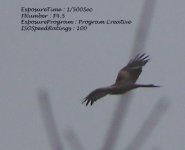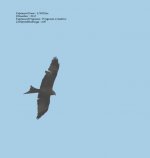How can I ever manage to get a decent photo of a bird in flight?
I have dozens and dozens of photos of a clear blue sky.
I am using the Olympus750UZ with the Tcon17. When I focus on the subject bird, I half press the button to bring it into focus, by the time that has happened, the bird has buggered off, and is no longer in focus, or indeed, in the frame!
The attached were taken the other day, the red kite, I would have thought, is a good bird to practise photography on, as he tends to glide quite slow and is large enough to focus on. However, the pic is always blurred and very grainy. The photos were taken on a dark grey day, I substituted the dark sky on one of the photos for blue in PS Elements. I realise the dark day wasn't the best for taking pics.
What am I doing wrong? :h?:
I have dozens and dozens of photos of a clear blue sky.
I am using the Olympus750UZ with the Tcon17. When I focus on the subject bird, I half press the button to bring it into focus, by the time that has happened, the bird has buggered off, and is no longer in focus, or indeed, in the frame!
The attached were taken the other day, the red kite, I would have thought, is a good bird to practise photography on, as he tends to glide quite slow and is large enough to focus on. However, the pic is always blurred and very grainy. The photos were taken on a dark grey day, I substituted the dark sky on one of the photos for blue in PS Elements. I realise the dark day wasn't the best for taking pics.
What am I doing wrong? :h?:






